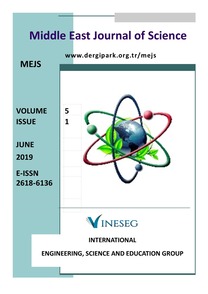DETERMINATION OF SUITABLE RHEOLOGICAL MODEL FOR POLYETHYLENE GLYCOLS AND SILICA PARTICLE MIXTURES
___
- R. L. Hoffman, “Discontinuous and dilatant viscosity behavior in concentrated suspensions. II. Theory and experimental tests,” J. Colloid Interface Sci., 1974, doi: 10.1016/0021-9797(74)90059-9.
- G. Bossis and J. F. Brady, “The rheology of Brownian suspensions,” J. Chem. Phys., 1989, doi: 10.1063/1.457091.
- W. H. Boersma, J. Laven, and H. N. Stein, “Viscoelastic properties of concentrated shear-thickening dispersions,” J. Colloid Interface Sci., 1992, doi: 10.1016/0021-9797(92)90385-Y.
- B. W. Lee, I. J. Kim, and C. G. Kim, “The influence of the particle size of silica on the ballistic performance of fabrics impregnated with silica colloidal suspension,” J. Compos. Mater., 2009, doi: 10.1177/0021998309345292.
- D. P. Kalman, R. L. Merrill, N. J. Wagner, and E. D. Wetzel, “Effect of particle hardness on the penetration behavior of fabrics intercalated with dry particles and concentrated particle-fluid suspensions,” ACS Appl. Mater. Interfaces, 2009, doi: 10.1021/am900516w.
- H. R. Baharvandi, M. Alebooyeh, M. Alizadeh, M. S. Heydari, N. Kordani, and P. Khaksari, “The influences of particle–particle interaction and viscosity of carrier fluid on characteristics of silica and calcium carbonate suspensions-coated Twaron® composite,” J. Exp. Nanosci., vol. 11, no. 7, pp. 550–563, 2016, doi: 10.1080/17458080.2015.1094190.
- M. Hasanzadeh, V. Mottaghitalab, and M. Rezaei, “Rheological and viscoelastic behavior of concentrated colloidal suspensions of silica nanoparticles: A response surface methodology approach,” Adv. Powder Technol., vol. 26, no. 6, pp. 1570–1577, Nov. 2015, doi: 10.1016/j.apt.2015.08.011.
- S. Gürgen, “An investigation on composite laminates including shear thickening fluid under stab condition,” J. Compos. Mater., vol. 53, no. 8, pp. 1111–1122, Apr. 2019, doi: 10.1177/0021998318796158.
- Y. Xu, “Stabbing Resistance of Soft Ballistic Body Armour Impregnated with Shear Thickening Fluid,” 2016.
- Q. Chen, M. Liu, S. Xuan, W. Jiang, S. Cao, and X. Gong, “Shear dependent electrical property of conductive shear thickening fluid,” Mater. Des., vol. 121, pp. 92–100, May 2017, doi: 10.1016/j.matdes.2017.02.056.
- L. L. Sun, D. S. Xiong, and C. Y. Xu, “Application of shear thickening fluid in ultra high molecular weight polyethylene fabric,” J. Appl. Polym. Sci., vol. 129, no. 4, pp. 1922–1928, Aug. 2013, doi: 10.1002/app.38844.
- J. Ge, Z. Tan, W. Li, and H. Zhang, “The rheological properties of shear thickening fluid reinforced with SiC nanowires,” Results Phys., vol. 7, pp. 3369–3372, 2017, doi: 10.1016/j.rinp.2017.08.065.
- M. Hasanzadeh and V. Mottaghitalab, “Tuning of the rheological properties of concentrated silica suspensions using carbon nanotubes,” Rheol. Acta, vol. 55, no. 9, pp. 759–766, Sep. 2016, doi: 10.1007/s00397-016-0950-7.
- M. Zabet, K. Trinh, H. Toghiani, T. E. Lacy, C. U. Pittman, and S. Kundu, “Anisotropic Nanoparticles Contributing to Shear-Thickening Behavior of Fumed Silica Suspensions,” ACS Omega, vol. 2, no. 12, pp. 8877–8887, 2017, doi: 10.1021/acsomega.7b01484.
- F. J. Rubio-Hernández, A. I. Gómez-Merino, N. M. Páez-Flor, and J. F. Velázquez-Navarro, “On the steady shear behavior of hydrophobic fumed silica suspensions in PPG and PEG of low molecular weight,” Soft Mater., 2017, doi: 10.1080/1539445X.2016.1242501.
- J. Santos, N. Calero, L. A. Trujillo-Cayado, and J. Muñoz, “Development and characterisation of a continuous phase based on a fumed silica and a green surfactant with emulsion applications,” Colloids Surfaces A Physicochem. Eng. Asp., 2018, doi: 10.1016/j.colsurfa.2018.07.017.
- C. Contado, L. Ravani, and M. Passarella, “Size characterization by Sedimentation Field Flow Fractionation of silica particles used as food additives,” Anal. Chim. Acta, 2013, doi: 10.1016/j.aca.2013.05.056.
- M. Singh, S. K. Verma, I. Biswas, and R. Mehta, “Rheology of fumed silica and polyethylene glycol shear thickening suspension with nano-clay as an additive,” Def. Sci. J., 2019, doi: 10.14429/dsj.69.12420.
- ISSN: 2618-6136
- Yayın Aralığı: Yılda 2 Sayı
- Başlangıç: 2015
- Yayıncı: INESEG Yayıncılık
DETERMINATION OF SUITABLE RHEOLOGICAL MODEL FOR POLYETHYLENE GLYCOLS AND SILICA PARTICLE MIXTURES
Murat Yavuz SOLMAZ, Cenk YANEN, Ercan AYDOĞMUŞ
A HYBRID MULTI-CRITERIA DECISION MAKING METHOD FOR ROBOT SELECTION IN FLEXIBLE MANUFACTURING SYSTEM
Shafi AHMAD, Sedat BİNGÖL, Saif WAKEEL
ESSENTIAL ELEMENTS AND HEAVY METAL LEVELS IN SHEEP MILK AND ITS DAIRY PRODUCTS
Serap KILIÇ ALTUN, Mehmet Emin AYDEMİR
Cenk YANEN, Ercan AYDOĞMUŞ, MURAT YAVUZ SOLMAZ
Shafi AHMAD, Sedat BİNGÖL, Saif WAKEEL
COMPARATIVE ASSESSMENT OF DOSE CALIBRATORS USED IN NUCLEAR MEDICINE
Merve CİNOĞLU KARACA, Duygu TUNÇMAN GENÇ, Hatice KOVAN, Mehmet MÜLAZIMOĞLU, Bayram DEMİR
COMPARATIVE ASSESMENT OF DOSE CALIBRATORS USED IN NUCLEAR MEDICINE
Merve CİNOĞLU KARACA, Duygu TUNÇMAN GENÇ, Hatice KOVAN, Mehmet MÜLAZIMOĞLU, Bayram DEMİR
